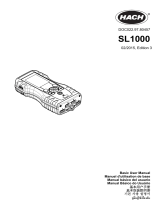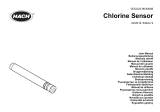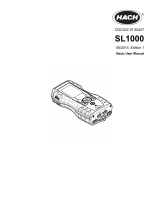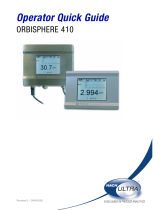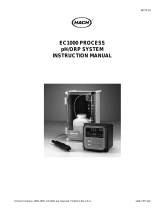Page is loading ...

Catalog Number 16116
8450 Residual Free Chlorine Monitor
INSTRUMENT MANUAL
© Hach Company, 2003. All rights reserved. Printed in the U.S.A.
ap/dk 07/03 2ed

Visit http: //www.hach.com

Page 3
16116TOC.fm Table of Contents
Table of Contents
Safety Precautions.................................................................................................................................................... 6
Specifications ............................................................................................................................................................ 7
Section 1 Introduction ........................................................................................................................................ 9
1.1 Introducing the Sigma Residual Chlorine Monitor Model 8450........................................................................... 9
1.2 Overview of Chlorine Characteristics.................................................................................................................. 9
1.2.1 Free Chlorine ............................................................................................................................................. 9
1.2.2 Probe Response and Effects of pH ........................................................................................................... 9
Section 2 Installation......................................................................................................................................... 11
2.1 Overview ........................................................................................................................................................... 11
2.2 Monitor Mounting .............................................................................................................................................. 11
2.2.1 Wall Mounting .......................................................................................................................................... 11
2.3 Panel Mounting the 8450 .................................................................................................................................. 12
2.3.1 Panel Mounting Considerations............................................................................................................... 12
2.3.2 Panel Mounting Sequence....................................................................................................................... 12
2.4 Rail-Mount Mounting......................................................................................................................................... 14
2.5 Probe Mounting................................................................................................................................................. 14
2.5.1 Submerged Probe Mounting.................................................................................................................... 14
2.5.2 Flow Cell Mounting .................................................................................................................................. 14
2.6 Electrical Connections ...................................................................................................................................... 16
2.6.1 ac Power.................................................................................................................................................. 16
2.6.2 Relay (Alarms) and Output Connections ................................................................................................. 17
2.6.3 Connecting the Probe.............................................................................................................................. 17
2.7 4-20 mA Surge Protector .................................................................................................................................. 18
2.7.1 Connections and Setup ........................................................................................................................... 19
2.7.2 Test and Check Procedure ...................................................................................................................... 20
2.7.3 4-20 mA Device Connection .................................................................................................................... 20
2.8 Data Communications....................................................................................................................................... 21
2.8.1 RS232 Communications.......................................................................................................................... 21
2.9 RS485 Communications ................................................................................................................................... 23
2.10 Probe Preparation ........................................................................................................................................... 24
2.11 New Membrane Pre-qualification Testing........................................................................................................ 24
2.12 Probe Preparation Procedure ......................................................................................................................... 25
Section 3 Operation........................................................................................................................................... 27
3.1 Overview ........................................................................................................................................................... 27
3.2 Front Panel Display and Controls...................................................................................................................... 27
3.3 Menus and Parameters..................................................................................................................................... 28
3.3.1 Main Screen ............................................................................................................................................ 28
3.3.2 Main Menu............................................................................................................................................... 28
3.4 Accessing and Changing System Parameters .................................................................................................. 28
3.4.1 Function Icon ........................................................................................................................................... 28
3.4.2 Arrow Icons.............................................................................................................................................. 29
3.4.3 Enter/Exit Icon ........................................................................................................................................ 29
3.5 Factory Default Parameters .............................................................................................................................. 30
3.6 Adjusting Display Screen’s Contrast ................................................................................................................. 30

Page 4
Table of Contents
16116TOC.fm
Table of Contents
3.7 Initial Power-Up and Self Test ........................................................................................................................... 31
3.7.1 *Check* Messages .................................................................................................................................. 31
3.7.2 Inhibiting Messages................................................................................................................................. 31
3.8 LCD Menu Descriptions .................................................................................................................................... 32
3.9 Setting Main Screen Time, Date, Temperature, and Concentration Units......................................................... 33
3.10 Setting Maximum Range................................................................................................................................. 33
3.11 System Calibration .......................................................................................................................................... 33
3.12 Frequency of Calibration ................................................................................................................................. 34
3.13 Considerations Before You Calibrate .............................................................................................................. 34
3.13.1 Probe Preparation and Setup ................................................................................................................ 34
3.13.2 Stabilization Issues................................................................................................................................ 35
3.13.3 Probe Signal Stability and Amplitude .................................................................................................... 35
3.13.4 Probe Temperature Considerations ....................................................................................................... 35
3.13.5 Operational Considerations ................................................................................................................... 36
3.14 Zero Calibration............................................................................................................................................... 36
3.14.1 Preparation ............................................................................................................................................ 36
3.14.2 Optimizing Zero Calibration ................................................................................................................... 36
3.14.3 Zero Calibration Procedure ................................................................................................................... 37
3.15 Span Calibration.............................................................................................................................................. 37
3.15.1 Preparation ............................................................................................................................................ 38
3.15.2 Optimizing Span Calibration .................................................................................................................. 38
3.15.3 Span Calibration Procedure .................................................................................................................. 39
3.16 Relative Probe Sensitivity ............................................................................................................................... 39
3.17 Alarm Setup .................................................................................................................................................... 40
3.17.1 Set Point Adjustment ............................................................................................................................. 40
3.17.2 High Set Point Setup ............................................................................................................................. 40
3.17.3 Low Set Point Setup .............................................................................................................................. 40
3.17.4 Selecting Alarm Relay Options (lfit)....................................................................................................... 41
3.17.5 Check Alarm Relay Setup ..................................................................................................................... 41
3.17.6 Alarm Time Delays ................................................................................................................................ 42
3.18 VMA Output Setup ......................................................................................................................................... 42
3.19 System Security .............................................................................................................................................. 42
3.20 Changing Site Location Designation ............................................................................................................... 43
3.21 Changing Display Precision ............................................................................................................................ 43
3.22 Damping Adjustment....................................................................................................................................... 43
3.23 Optional Data Logger...................................................................................................................................... 44
3.23.1 SETTINGS Menu — Data Log Setup .................................................................................................... 45
3.23.2 Sampling Rate ....................................................................................................................................... 46
3.23.3 Control Parameters — On-Off-Reset..................................................................................................... 46
3.23.4 DATA Menu — Viewing Trend Data-Log Records On Screen................................................................ 46
3.23.5 REPORTs — Printing Trend Data.......................................................................................................... 47
3.23.6 Other Data Logger Considerations........................................................................................................ 48
3.24 SYS Menu ....................................................................................................................................................... 48
3.24.1 Gpot....................................................................................................................................................... 48
3.24.2 ADC ....................................................................................................................................................... 49
Section 4 Maintenance and Troubleshooting ............................................................................................. 51
4.1 Maintenance Overview...................................................................................................................................... 51

Table of Contents
Page 5
16116TOC.fm Table of Contents
4.2 Probe Maintenance and Poor Probe Output ..................................................................................................... 51
4.2.1 Membrane Troubleshooting and Maintenance......................................................................................... 51
4.2.2 Quick Membrane Replacement Procedure.............................................................................................. 51
4.2.3 Probe Electrode Maintenance ................................................................................................................. 52
4.2.4 Testing Thermistor Output ....................................................................................................................... 53
4.2.5 Testing for Electrical Isolation .................................................................................................................. 54
4.3 Resolving Calibration Problems ........................................................................................................................ 54
4.3.1 Timer Expires During Zero Calibration .................................................................................................... 55
4.3.2 Timer Expires During Span Calibration ................................................................................................... 56
4.4 Reading Drifts After Span Calibration ............................................................................................................... 57
4.5 Calibration Error Messages............................................................................................................................... 57
4.6 Calibrating with a Simulated Input..................................................................................................................... 57
4.6.1 Equipment Required................................................................................................................................ 57
4.7 *CHECK* Messages (Alphabetical Listing)....................................................................................................... 59
4.8 Resetting Factory Defaults................................................................................................................................ 60
Replacement Parts and Accessories ...................................................................................................................... 61
Contact Information for U.S.A. and Outside Europe ............................................................................................... 63
Contact Information for Europe............................................................................................................................... 64
Warranty ................................................................................................................................................................. 65

Page 6
Safety Precautions
16116Safety.fm
Safety Precautions
Please read this entire manual before unpacking, setting up, or operating this instrument.
Pay particular attention to all danger and caution statements. Failure to do so could result in serious injury to the
operator or damage to the equipment. To ensure the protection provided by this equipment is not impaired, do not
use or install this equipment in any manner other than that which is specified in this manual.
Use of Hazard Information
If multiple hazards exist, this manual will use the signal word (Danger, Caution, Note) corresponding to the
greatest hazard.
DANGER: Indicates a potentially or imminently hazardous situation which, if not avoided, could
result in death or serious injury.
CAUTION: Indicates a potentially hazardous situation that may result in minor or moderate injury.
Note: Information that requires special emphasis.
Precautionary Labels
Read all labels and tags attached to the instrument. Personal injury or damage to the instrument could occur if
not observed.
This symbol, if noted on the instrument, references the instruction manual for operation
and/or safety information.
This symbol, when noted on a product enclosure or barrier, indicates that a risk of electrical shock
and/or electrocution exists and indicates that only individuals qualified to work with hazardous voltages
should open the enclosure or remove the barrier.
This symbol, when noted on the product, identifies the location of a fuse or current limiting device.
This symbol, when noted on the product, indicates that the marked item can be hot and should not be
touched without care.
This symbol, when noted on the product, indicates the presence of devices sensitive to Electro-static
Discharge and indicates that care must be taken to prevent damage to them.
This symbol, when noted on the product, identifies a risk of chemical harm and indicates that only
individuals qualified and trained to work with chemicals should handle chemicals or perform
maintenance on chemical delivery systems associated with the equipment.
This symbol, if noted on the product, indicates the need for protective eye wear.
This symbol, when noted on the product, identifies the location of the connection for Protective Earth
(ground).

Page 7
16116Specs.fm Specifications
Specifications
Specifications are subject to change without notice.
Repeatability ±0.5%
Linearity ±0.5%
Output Range 0–20 ppm (selectable)
Displayed Precision 0.01, 0.1, 1
Damping Time Constant 0–300 seconds
Power 110/220 V ac (switchable)
Monitor Enclosure NEMA-4X (wall), NEMA-12(panel)
Monitor Temperature Limits -20 to 50 °C (-4 to 122°F)
Alarm LEDs 3 (red)
Analog Outputs
Concentration and temperature (°F and °C)
(2) 4-20 mA (or 20-4 mA) isolated into 800 ohm max.
(2) 0–1 or 0–5 V dc
Alarm Relays (2) 5A SPDT @ 110 V ac; (1) 5A SPDT @ 110 V ac
Alarm Relay Controls Latching, fail-safe, inhibit, and test
Security Features 3-digit entry w/confirmation
Probe type Temperature compensated (RTD), direct sensing membrane probe
Probe Temperature Limits 0 to 50 °C (32 to 122 °F)
Max pressure at probe 50 PSI
Probe Material PVC
System Shipping Weight 8 lbs.
Data Logger
Sampling Interval 1–90 minutes, selectable intervals
Max data points 13,000 @ 1 min. intervals
On Screen Report Daily high, low, avg. concentration. Individual.

Visit http: //www.hach.com

Page 9
16116Intro.fm Introduction
Section 1 Introduction
1.1 Introducing the Sigma Residual Chlorine Monitor Model 8450
Sigma Chlorine monitors are designed for on-line measurement of residual
chlorine concentrations in potable water, cooling towers, or wastewater. The
system consists of two main components: a programmable electronic monitor
housed within a NEMA-4X enclosure and an amperometric membrane probe.
The 8450 Monitor comes fully equipped with a variety of features. Monitor
operation and programming is accomplished via a magnet which, when
touched to the unit’s front panel icons, activates small internal switches and
permits adjustment of the various operation/set-up parameters. Each unit’s
alarm capabilities include two programmable high/low alarms and a fault
alarm. Four analog outputs are provided for operation of external alarm and
control devices. Chlorine levels from 0.00 to 20.0 ppm are displayed on an
auto-ranging LCD where concentrations may be viewed in either ppm or
mg/L. Other features include: password security, optional data logging, and an
optional RS232/RS485 communications port for remote monitoring and
system operation.
Sigma chlorine probes provide the means to directly measure chlorine. The
Model 8450 Monitor and its associated model 50 probes will respond to both
hypochlorous acid and the hypochlorite ion. Probes respond best in liquid
environments of up to a pH of 9; however, probes should be calibrated in the
pH at which measurements will be taken to obtain optimum accuracy. The
probe can be used in a constant-head flow assembly that provides better flow
control and enhances the operating environment for the probe.
1.2 Overview of Chlorine Characteristics
1.2.1 Free Chlorine
When chlorine (Cl
2
) is dissolved in water (H
2
O) it hydrolyzes (the reaction
between an ion and water in which the hydrogen–oxygen bond is broken) to
form hypochlorous acid or free chlorine:
Cl
2
+ H
2
O → HOCl + H
+
+ Cl
–
Hypochlorous acid is considered a “weak” acid and therefore tends to partially
dissociate and produce a hydrogen ion and a hypochlorite ion:
HOCl ↔ H
+
+ OCl
–
The combination of HOCl and OCl
–
is referred to as free chlorine. The extent
to which this dissociation occurs depends upon several factors, including the
temperature and pH of the solution. At pH levels between 6 and 9.5, the
dissociation of the hypochlorous acid is incomplete, thus both hypochlorous
acid and the hypochlorite ion will be present within the solution (see Figure 1).
The Model 8450 Free Chlorine Monitor has been designed to measure these
two species of dissolved chlorine.
1.2.2 Probe Response and Effects of pH
The pH of the water has a definite effect on the response of Model 8450 Free
Chlorine probes. In general, probes will begin to exhibit a reduced response
as pH levels increase above 7.5.

Page 10
Overview of Chlorine Characteristics
16116Intro.fm
Section 1
The effect of pH on the Sigma Free Chlorine probe is illustrated in Figure 1.
The Sigma Free Chlorine probe has a response that goes beyond the HOCl
species, and that it has a usable response to the hypochlorite ion (OCl
–
). This
enables the Sigma probe to be used at higher pH values than if it only
responded to hypochlorous acid. Depending upon expected pH swings, the
Free Chlorine probe response is not significantly affected below a pH of about
8. If the pH is constant, the probe can be calibrated and used at up to pH 9;
however, large pH swings centered at about pH 9 can cause errors. If the pH
is to be kept between 5 and 6 (i.e. 100% HOCl residual), a Sigma CO
2
Sparging system is recommended.
Figure 1 HOCl–OCl
–
Equilibrium and Sigma Free Chlorine Probe Outputs vs. pH
Sigma Standard Free Cl Sensor Response
2
Point (a) — Equal Parts HOCl and OCl
Point (b) — 80% HOCl and 20% OCl (example)
–
–
Greater
HOCl
Greater
OCl
Equal Parts
HOCl & OCl
–
a
b
-
-

Page 11
16116Install.fm Installation
Section 2 Installation
2.1 Overview
Installation of the residual chlorine monitor consists of mounting and wiring
the monitor, pipe-mounting the probe (for submersion applications), and
connecting sample and drain lines for applications requiring flow cell usage.
Connect the probe to the electronics module by plugging the probe multi-pin
plug into the receptacle at the bottom of the electronic module.
2.2 Monitor Mounting
The programmable electronic monitor is enclosed in a NEMA-4X enclosure
that can be mounted to a wall, through a panel, or onto a handrail or pole.
2.2.1 Wall Mounting
Two mounting brackets (one on each side) are attached to the monitor with
four screws (supplied). With the bracket tabs and mounting holes extending
beyond the monitor on each side, the monitor can be attached to a wall or flat
surface using four [need size] screws and appropriate mounting hardware.
Figure 2 Monitor with Wall Mount Brackets
Figure 3 Wall Mount Brackets (Rear View)
9.75" (24.8 cm)
8.75" (22.2 cm) c-c
8.4" (21.3 cm)
4" (10.1 cm)
4.875" (12.4 cm)
6.4" (16.2 cm)
RESIDUAL CHLORINE MONITOR

Page 12
Panel Mounting the 8450
16116Install.fm
Section 2
Figure 4 Wall Mounted Monitor’s Depth
2.3 Panel Mounting the 8450
2.3.1 Panel Mounting Considerations
To install the panel-mount enclosure, remove the monitor’s four front panel
securing screws and the front-panel. Install the panel mount installation plate
(Cat. No. 16411). Note that the probe receptacle in a panel-mount application
may not be easily accessible behind the panel. For many panel-mount
applications, it may be advisable to wire the probe connections out to an
optional junction box near the probe location. The junction box contains a
receptacle for plugging in the probe (see Figure 11 on page 18). The junction
box should be no more than 200 feet from the monitor.
2.3.2 Panel Mounting Sequence
To attach the panel mount kit brackets, refer to Figure 5 and Figure 6 and
proceed as follows:
1. Attach the Z-brackets (Cat. No. x) using 1/4-20 x 0.25” L hex bolts at the
back of the meter. Do not completely tighten the bolts at this time.
2. Remove the front panel (4 screws) and position the Enclosure Plate.
3. Reattach the front panel with the Enclosure Plate sandwiched
underneath it.
4. Attach the Enclosure Plate to the Z-brackets with four screws and tighten
all screws to finish the assembly.
5.1" (13.0 cm)

Section 2
Page 13
16116Install.fm Panel Mounting the 8450
Figure 5 Panel Mounted Meter (Front View)
Figure 6 Panel Mount Attaching Parts (Side View)
1. Enclosure Plate 4. Panel
2. #10-32 x 0.75 stainless slotted hex washer-head
machine screw
5. 1/4-20 x 0.25 stainless steel machine screw
3. 1/4-20 x 0.75 stainless slotted hex wahser-head machine
screw
6. Z-bracket
RESIDUAL CHLORINE MONITOR
8.2” (20.8 cm)
10.7” (27.1 cm)
6
5
4
3
2
1

Page 14
Rail-Mount Mounting
16116Install.fm
Section 2
2.4 Rail-Mount Mounting
The Rail-Mount kit (Cat. No. 16088) allows the meter to be clamped to a hand
rail (that runs horizontally) or even to a pole (vertical pipe) if so desired (Figure
7). Brackets that attach to the back of the meter are in turn attached to the rail
or pole with U-bolt type pipe clamps. The brackets may be attached to the
sides (rail mount) or top and bottom (pole mount).
Figure 7 Rail or Pole Mount Brackets
2.5 Probe Mounting
The chlorine probe is suitable for either submersion or flow-cell use. In
general, the flow-cell system is preferable.
Note: In either case, it is essential that a flow velocity of at least 0.5 ft./sec., but not
greater than 2.5 ft./sec., is maintained at the probe.
2.5.1 Submerged Probe Mounting
For submerged applications, the chlorine probe is mounted at the end of a 1"
pipe using pipe mounting kit. Figure 8 shows the proper pipe mounting
assembly. Note that the pipe mounting kit does not include the pipe.
2.5.2 Flow Cell Mounting
Use a flow cell for free chlorine applications in situations where a uniform flow
across the membrane cannot be assured by other means.
The flow cell assembly contains a clear flow block into which the probe is
inserted and a constant head overflow that controls the flow through the cell.
The flow cell will operate with a minimum of 8 gph and a maximum of 25 gph.
If the supply for the flow-cell is variable in pressure, as is common in potable
water systems, place a pressure regulator with an outlet pressure of 10 to
15 psi ahead of the flow-cell.
Flow assemblies are wall mounted using the bolt holes in the four corners of
the assembly plates. Recommended sample piping is shown in Figure 9. The
probe is inserted into the flow-cells using a twist-lock arrangement. Align the
three pins in the probe with the slots in the flow-cell and press the probe down
until it can be turned slightly to engage the pins in the retaining slot. If
excessive force is required to press the probe past the sealing o-ring, remove
the o-ring and apply a small amount of silicone lubricant.

Section 2
Page 15
16116Install.fm Probe Mounting
Figure 8 Submerged Probe Using Pipe Mount Kit
1. Probe Cable to Monitor 5. 1” (2.54 cm) FNPT
2. 1.5” (3.8 cm) diam. Handrail 6. Probe Adapter Cone
3. 1” (2.54 cm) Schedule 80 PVC pipe (Customer-supplied,
length as required.)
7. Probe
4. Probe 8. Pipe Bracket
6
5
4
3
2
1
8
7

Page 16
Electrical Connections
16116Install.fm
Section 2
Figure 9 Flow Cell and Connections (Typical)
2.6 Electrical Connections
Electrical connections required for the residual chlorine monitor include probe
connection, ac power connection, and connection of analog outputs and
alarm relays, if they are being used. Figure 10 shows the terminals to which
connections are made for the various functions. If the unit being installed is a
1. Mounting Plate 5. Water Line
2. Flow Cell 6. Pressure Regulator (10–15 psi Output)
3. 0.5” Outlet 7. 0.25” Inlet (Inlet Flow = 8 to 25 gph)
4. Hand Valve
8.0” (20.3 cm)
7.5” (19.1 cm)
6.0” (15.2 cm)
5.5” (14.0 cm)
Mounting Plate
Flow Cell
0.5” Outlet
Hand Valve
Pressure Regulator
(10–15 PSI Output)
Water Line
0.25” Inlet
(Inlet Flow = 8 to 25 gph)

Section 2
Page 17
16116Install.fm Electrical Connections
panel-mount system, it is best to make all connections at the time of physical
installation.
2.6.1 ac Power
Wall mounted chlorine monitors are shipped with the power cord already
connected. If no outputs or alarms are to be used, all that is necessary is to
plug the probe cable into the receptacle at the bottom of the enclosure and
plug the power cord into a standard wall receptacle.
ac power can also be routed directly to the monitor in panel-mount
installations by connecting Line (L), Neutral (N), and ground (GND)
connections as shown in the Figure 10.
2.6.2 Relay (Alarms) and Output Connections
Warning: Remove ac power to the instrument before proceeding.
In order to access the terminal strip to make relay and output connections,
remove the four screws from the front panel and remove the front panel. Next,
remove the two screws on the right side of the display board (the display
board is hinged) and swing the display board out of the way. Make all
necessary connections in accordance with the Figure 10 and reassemble the
enclosure.
Connection mnemonics are V1 and V2 (voltage 1 and 2), I1 and I2 (current 1
and 2), AL1 (alarm 1), AL2 (alarm 2), and CHK (check relay).
Figure 10 Electrical Connections
2.6.3 Connecting the Probe
The two basic methods of connecting the probe are:
• Directly connecting the probe connector to monitor-connector P1 and,
• Connecting the probe connector to an intervening junction box.
The second method allows greater distance between the monitor and the
probe (up to 200 ft. between monitor and probe connector). It also is useful in

Page 18
4-20 mA Surge Protector
16116Install.fm
Section 2
those cases where this extended cable is to be routed through a conduit.
Figure 11 and Tabl e 1 depict the cable connections.
Figure 11 Probe Connection Options
2.7 4-20 mA Surge Protector
Required Materials
• Standard straight-slot screw driver
Direct Connection Connection Using Screw-Teminal Junction Box
Probe Connector (P1)
Junction Box Cable
Removable Face Plate
Probe Connector
Leads End
Connector
Junction Box
Table 1 Probe Conductor Identification
Probe Cable Color
Junction Box Bendix
Connector P2
Junction Box
Terminal Block
Junction Box Cable
Color
Monitor Bendix
Connector P1
Black D 4 Black D
Brown B 2 Brown B
White A 1 White A
Red C 3 Red C
Shield E 5 Shield Connector’s Shell

Section 2
Page 19
16116Install.fm 4-20 mA Surge Protector
• Small straight-slot screw driver
• Milliampmeter
• Color-coded connection wire, 10 in. (25.4 cm)/test leads
• 4-20 mA Surge Protector(s) (Cat. No. 16326)
2.7.1 Connections and Setup
Warning: Remove ac power to the instrument before proceeding.
1. Remove electrical power to the meter.
2. Unscrew the four cover face plate screws and remove the cover.
3. Unscrew the upper and lower right screws that hold the display circuit
board to the meter and swing the hinged display board back to access the
main circuit board inside the case.
4. As shown in Figure 12, insert the two pins of the Surge Protectors into
pins 7 and 8 (channel 1) and 5 and 6 (channel 2) on the terminal block.
5. Tighten the clamp screws on this connector.
Figure 12 Top View of Pins and Terminal Block
6. Connect the wires from the color-coded wire into surge protector terminal
screws. Route the wires through the bottom of the case (under the
display) and label the wires for channel 1 and 2 and + and –.
7. Temporarily tape the ends of channel 2 wires to avoid the possibility of
shorts. Connect a milliampmeter to the channel 1 extension leads.
8. Plug the screw-terminal block with attached surge protectors installed into
TB4 connector on the 8400 meter’s main circuit board (Figure 13.)
Note: The plug-in screw terminal connector is keyed to ensure that it plugs in correctly.
Note: The location of TB4 and its numbered terminals are marked on the main circuit
board.
Figure 13 Plug-in Connector in Place
9. Swing the display back into the closed position, using care to avoid
pinching or snagging wires (Figure 14).
Figure 14 Extension Leads and Milliampmeter Connections
10. Power the meter on again and proceed to section 2.7.2.

Page 20
4-20 mA Surge Protector
16116Install.fm
Section 2
2.7.2 Test and Check Procedure
2.7.3 4-20 mA Device Connection
This process contains three major steps:
• Hooking the 4-20 mA device in series with a milliampmeter and the 8400
meter.
• Performing the 4 mA and 20 mA adjustments for each device on each
channel.
• Removing the milliampmeter and connecting the 4-20 mA device directly
to the surge protectors on each channel.
Activate Result
F1.From the Main screen brings up the Main menu.
↑ 2. Several times to move to >VMA.
E3.Selection menu: CH1, CH2, ADJ.
↑ 4. Several times to move to >ADJ.
E5.Channel selection screen: >---NONE---.
E6.Enter channel selection. [---NONE--- blinks.]
↑ 7. “CH 1 4.00 mA” display blinks.
E8.Enters > CH1 4.00 mA [only (>) blinks].
9. Milliampmeter displays 4 mA ±2% (3.92 to 4.08 mA).
↓ 10. Adjust mA Output. To select > Adjust---.
E 11. Enters Adjust.
↑↓
12. Adjust output up or down as need until milliampmeter reads
4 mA ±2% (3.92 to 4.08) mA.
E 13. Enters (accepts the adjustment).
↑ 14. Return to channel selection. [Displays: >CH1 4.00 mA...]
E 15. Enter Channel selection.
↑ 16. “CH 1 20.0 mA” display blinks.
E 17. Enters >CH1 20.0 mA [only (>) blinks].
18. Milliampmeter displays 20 mA ±2% (19.6 to 2.04 mA).
↓ 19. Adjust 20 mA Output: To select >Adjust---.
E 20. Enters Adjust.
↑↓
21. Adjust output up or down as needed until milliampmeter reads
20 mA ±2% (19.6 to 2.04 mA).
E 22. Enters (accepts) the adjustment.
23. Continue On to Check Channel 2 in the same manner. Move
milliampmeter leads to channel 2 extension leads and tape
insulate the bare channel 1 leads to avoid the possibility of
shorting.
↑ 24. Moves to the channel line of the menu.
E 25. Channel menu line blinks.
↑ (5 times) 26. Displays CH2 4.00 mA.
E 27. Enters > CH2 4.00 mA [only (>) blinks].
28. Repeat steps 9 through 22 to check 4 mA and 20 mA outputs
of channel 2.
/
